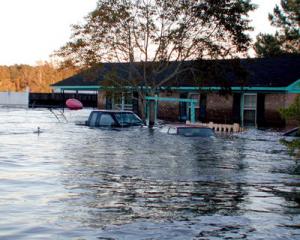Flood insuranceBetter FEMA options for increasing the affordability of flood insurance
FEMA currently does not have the policy analysis capacity or necessary data to comprehensively analyze different options for making flood insurance more affordable. A new report identifies an approach for the Federal Emergency Management Agency (FEMA) to evaluate policy options for making premiums through the National Flood Insurance Program (NFIP) more affordable for those who have limited ability to pay.

No flood insurance makes this a total loss // Source: noaa.gov
A new report from the National Academies of Sciences, Engineering, and Medicine identifies an approach for the Federal Emergency Management Agency (FEMA) to evaluate policy options for making premiums through the National Flood Insurance Program (NFIP) more affordable for those who have limited ability to pay. Microsimulation is a modeling approach that is well-suited to estimating premiums and future flood damage claims at the individual policyholder level, the report says. A microsimulation modeling approach would, for example, allow FEMA to compare the price of NFIP premiums that reflect true flood risk — as called for in the Biggert-Waters Flood Insurance Reform Act of 2012 — with measures of policyholders’ ability to pay. The agency then could evaluate how different premium and mitigation assistance programs might be designed to make premiums affordable for cost-burdened households.
The National Academies says that FEMA currently does not have the policy analysis capacity or necessary data to comprehensively analyze different options for making flood insurance more affordable, the report says. For example, the NFIP’s database lacks first-floor elevation data for many properties, making it difficult to estimate those properties’ risk of flood damage or the premiums they would face under a risk-based pricing structure. Moreover, the NFIP database does not contain data on policyholders’ income, wealth, or housing costs. Because of this lack of data, FEMA cannot analyze the likely impact of federal assistance programs that consider such factors.
The report identifies some limited analyses FEMA can do now, and describes ways that the agency can build its modeling capacity and data resources to enable such analyses. The pace at which FEMA’s modeling capacity grows will depend on the resources available, access to appropriate expertise, and the support of agency leadership, the report says.
The committee that wrote the report also included further findings on topics examined in its March 2015 report, which discussed how NFIP premiums are set and the changes called for by the Biggert-Waters Act and the subsequent Homeowner Flood Insurance Affordability Act (HFIAA) of 2014. Biggert-Waters eliminated grandfathering — which had allowed policyholders to maintain their premium rates even if their property was subsequently mapped into a higher flood-risk zone — but HFIAA re-instated it. The new report describes how this reinstatement will limit the ability of the NFIP to employ risk-based pricing over time if climate change, land development, and more accurate mapping place more properties in higher flood risk zones. Other new findings focus on setting of premiums outside the 100-year floodplain, how the NFIP calculates the cost burden that premiums place on policyholders, the effects of risk-based pricing on property values, and the linking of flood insurance premium assistance with mitigation efforts.
The study was sponsored by FEMA.
— Read more in Affordability of National Flood Insurance Program Premiums: Report 2 (National Academies Press, 2015)
